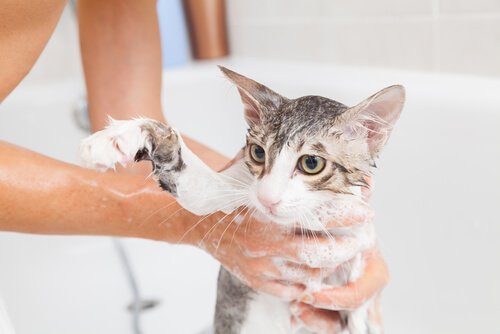Tips on How to Bathe Your Cat

Is it really necessary to bathe your cat? Well, cats are known for avoiding contact with water. So, this issue can be a problem if your cat needs a dunk. Continue reading for some tips on how to make it less traumatic –for you, and also for your pet.
Kitty lovers can’t agree on whether or not cats need to have baths. Furthermore, while it’s true that felines seem to keep themselves impeccably clean, some special situations may arise in which there will be no choice but to bathe your cat. For example:
- If they go roaming around the neighborhood and return covered in mud or with all kinds of debris stuck in their fur
- If they come into contact with toxic substances that would put them in danger if they lick themselves
- Or, lastly, if they need treatment for dermatological conditions
The ideal thing would be to start bathing cats when they’re small kittens so that they get used to it. However, it’s never too late to begin doing it. So, put on your patience coat and get to work. It’s certainly true that the only lost battles are those that aren’t fought.

Bathing your cat can be a difficult mission, but it’s not impossible. Here are some tips on how to go about it. You may not succeed at first, but with patience and affection you’ll surely get your cat to comply
Steps to follow to [try] to bathe your cat
Although it may be true that bathing your cat is a difficult mission, it’s not impossible. The idea is, then, is that you don’t stress the cat and that you survive the task. So:
- Before getting the cat in the water, make sure you have everything you need within reach, because, once you start, it’ll be practically impossible to get anything you forgot.
- Choose a time when your cat is relaxed. In the same way, play for a while with him so that he’s tired and won’t put up too much resistance when you bathe him.
- Don’t forget to brush him well before immersing him in the water. It’ll make it easier to remove loose hair, and also to deal with any knots he may have.
- Get someone else to help; one of you could hold him while the other one does the dirty work.
More recommendations

- Firstly, line the bottom of where you choose to bathe him with a non-slip element so that the animal doesn’t slip. Then fill it up with just a few inches of lukewarm water.
- Secondly, close any doors and windows to keep him from fleeing –oh yes, he’ll try. Also, don’t allow any other pets to enter while you bathe your cat.
- After that, pour water on your cat bit by bit, while he slowly get used to the situation. You can have some toys at hand in order to distract them. Moreover, if things get out of control, don’t force him, and try it again at a later time. If the bath can’t wait, then try to wipe him clean with a damp cloth.
- Furthermore, if you manage to immerse them in the water then just wet him only from the neck down and lather him gently, rinsing him well. Equally important, if his head and face aren’t too dirty then just wipe him down with a damp cloth.
- Another key point is to talk to him in a calm, smooth voice throughout the bath.
- Finally, dry the animal and place him in a warm place.